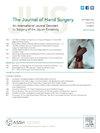Clinical Recovery of Spastic Finger Flexion Using Hyperselective Neurectomy: A Case Series
IF 2.1
2区 医学
Q2 ORTHOPEDICS
引用次数: 0
Abstract
Purpose
Hyperselective neurectomy (HSN) is an advanced peripheral nerve ablation procedure that can relieve spasticity and enhance the quality of life in patients with spasticity following upper motor neuron injuries. The main advantage of HSN is that it can treat spasticity as well as preserve hand function. Thus, HSN may be the procedure of choice in patients with spastic functional hands. In this study, we present the surgical technique and results of HSN of the flexor digitorum superficialis (FDS) in the setting of spastic finger flexion.
Methods
HSN of the FDS was performed on 18 patients with functional hands. We employed the Peraut and House categorizations to evaluate pain reduction and improvement of hand function, respectively.
Results
The patients exhibited marked improvement in finger spasticity following HSN. Finger function was preserved, and all patients demonstrated improved hand function, as evidenced by an increase in the House Score from 0 to 2 before surgery to a range of 4 to 8 after the intervention. All patients experienced relief from pain.
Conclusions
HSN of the FDS branch is a technique that should be considered to reduce finger flexor spasticity and preserve finger flexion function.
Type of study/level of evidence
Therapeutic IV.
利用分散神经切除术实现痉挛性手指屈伸的临床康复:病例系列
目的非选择性神经切除术(HSN)是一种先进的周围神经消融术,可以缓解上运动神经元损伤后痉挛患者的痉挛症状,提高其生活质量。HSN 的主要优点是既能治疗痉挛,又能保留手部功能。因此,HSN 可能是痉挛性功能手患者的首选手术。在本研究中,我们介绍了在手指痉挛性屈曲的情况下对屈指肌浅肌(FDS)进行 HSN 的手术技巧和结果。我们采用 Peraut 和 House 分类法分别评估疼痛减轻情况和手部功能改善情况。手指功能得以保留,所有患者的手部功能都得到了改善,House 评分从术前的 0 到 2 分提高到干预后的 4 到 8 分。所有患者的疼痛都得到了缓解。结论FDS分支的HSN是一种可减轻手指屈曲痉挛并保留手指屈曲功能的技术,值得考虑。
本文章由计算机程序翻译,如有差异,请以英文原文为准。
求助全文
约1分钟内获得全文
求助全文
来源期刊
CiteScore
3.20
自引率
10.50%
发文量
402
审稿时长
12 weeks
期刊介绍:
The Journal of Hand Surgery publishes original, peer-reviewed articles related to the pathophysiology, diagnosis, and treatment of diseases and conditions of the upper extremity; these include both clinical and basic science studies, along with case reports. Special features include Review Articles (including Current Concepts and The Hand Surgery Landscape), Reviews of Books and Media, and Letters to the Editor.

 求助内容:
求助内容: 应助结果提醒方式:
应助结果提醒方式:


